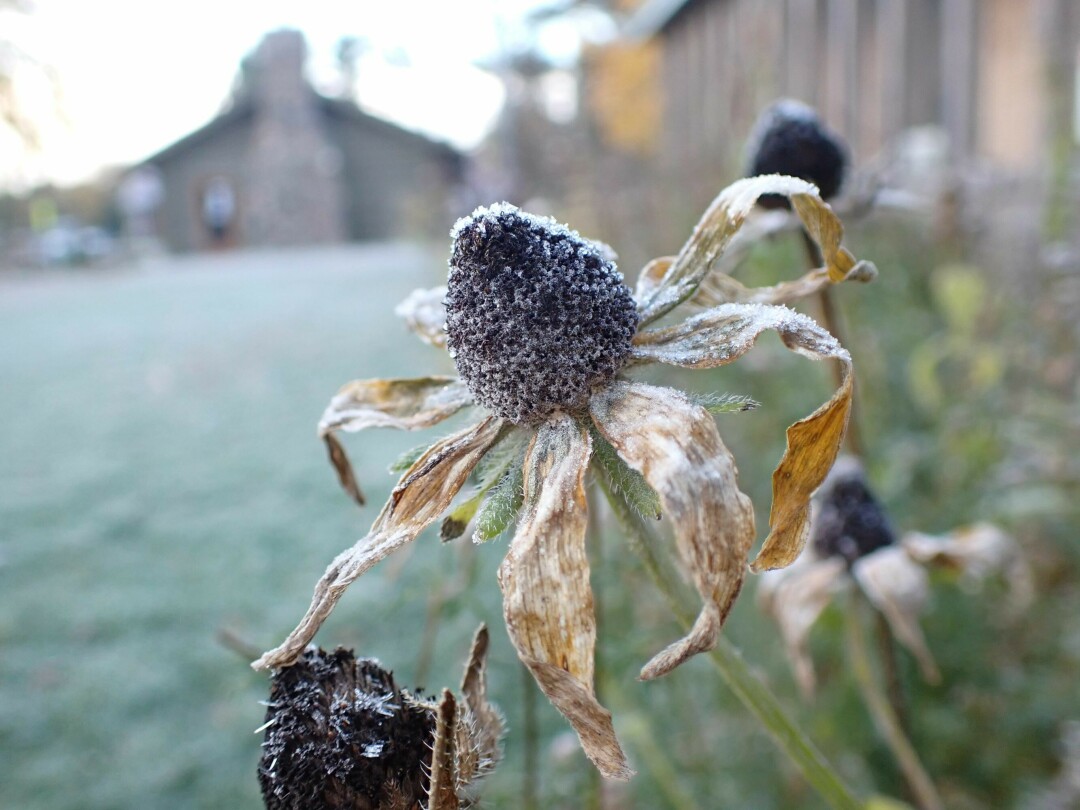News & Articles
Browse all content by date.

A frosty black-eyed Susan blossom will soon “settle closer to the bosom of the earth.” Photo by Emily Stone.
“November is a sigh; a sigh of weariness after the tumult of summer, a sigh of resignation over projects yet undone, a sigh of regret for hopes unfulfilled. It is a sigh of frustration that no matter how we try, the world seems to be sinking deeper into the morass, and a sigh of sadness that neither we nor those around us seem to live up to our expectations.”
So wrote Lois Nestel, the museum’s founding director and naturalist, more than three decades ago. It is a gray sentiment, to match the gray clouds and gray trees of this time of year.
I feel it, too. With little daylight left after work, it’s hard to want to get out for a walk. When I do, the air is damp and chilled, and the landscape dreary.
Lucky for us, Lois had the fortitude to continue past her sigh and philosophize about a different perspective we could take.
She wrote, “Nature also sighs, but in a gentler mood. It is the sigh of relaxation as hibernating creatures slip into their long sleep. It is the gusty sigh of pines yielding to the cold north wind and the almost silent sigh of leaves and grasses settling closer to the bosom of the earth beneath the gentle pressure of the snow.
“We are in limbo. It is an in-between time when looking forward appears as pointless as looking back. The short gray days and long black nights are conducive to dark thoughts…yet, why?
“The badge of hope is pinned to every twig as tightly furled buds encase next summer’s glory. The cocoon, hung high in the tree, is a symbol of faith in a warmer, bright day. Courage and cheer are exemplified in the sprightly chickadee, who finds joy in just being alive. Patience marks the bed of seed and spore. So, why the gloom of human spirit?
“Perhaps we have strayed too far from our beginnings. The wall of human thought and intellect that should have raised us to the heights of glory has instead separated us from the beauty of simplicity and faith. We demand, we demand. We have set ourselves upon a throne, despotic rulers of all we survey. Man is such a small cog in this complex world. Biologists have found an average of 1356 living creatures in the top inch of a square foot of forest soil; and did you know that the average size of all living animals, including man, is about that of a housefly? Yet we are so big in our own eyes!
“A proper perspective is what we need, and perhaps a closer bond with nature could teach us. That lesson learned, how good it would be if our sighs of dissatisfaction could become sighs of contentment and peace.” Lois must have been caught in this mood for several weeks, for a later essay of hers reflects these same themes of renewal and humans’ removal from it. Just as Lois saw hope in the form of a tree bud, she sees hope in demise of a rabbit, which might in fact provide nourishment for a future tree bud.
She wrote, “The first snow of the season blanketed the ground and reflected back the moonlight with unaccustomed brightness. Looking out, I thought the world seemed empty of life, silent and pristine. The illusion was soon shattered as from somewhere in the shadows of the trees came the piercing, quavering cry of a rabbit, rising to a shriek and then ending abruptly.
“My first thought was, “Oh, the poor thing—what a pity.” I believed it to be the work of a resident great horned owl, and I pictured the silent swoop, the clutch of talons and the great, tearing beak. Then, lying back, I mulled over the subject.
“The death was but a link in the chain and sad only for the rabbit. For the owl, as prime predator, it was cause for fierce pleasure and satisfaction, a sustaining of life. Lesser creatures would glean crumbs from his table, bits of flesh and bone to be gnawed by mice and shrews, to be picked by birds; nests would be lined in spring with scattered hair. Remnants of body wastes and liquids would sink into the earth to nourish next year’s blade or twig which in turn would nourish, perhaps, another rabbit in the passage of time.
“Left to its normal management there is no waste in nature. Part of the owl flying in the night sky and the beetle beneath dead leaves is the rabbit who ate the twig whose nutrients came from death and decay. Everything uses and is used, is changed and converted but never lost.
“I regret that human standards have removed us from the natural chain. Human civilization has come to mean constant taking, seldom returning. How long will nature tolerate us?
Lois’s perspective brings comfort in this gray season, and I resolve to take my next walk with eyes open to the life curled up inside buds, the cocoons protecting delicate moths-to-be, the chickadees indomitable cheer, and the renewal inherent in every bit of death. Hopefully you, too, will find ways to ensure that your November sighs indicate contentment and peace.
Emily’s award-winning second book, Natural Connections: Dreaming of an Elfin Skimmer, is available to purchase at www.cablemuseum.org/books and at your local independent bookstore, too. For more than 50 years, the Cable Natural History Museum has served to connect you to the Northwoods. Our exhibit: “The Northwoods ROCKS!” is open through mid-March. Our Fall Calendar of Events is ready for registration! Follow us on Facebook, Instagram, YouTube, and cablemuseum.org to see what we are up to.
| Tweet |


